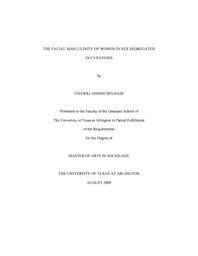
ATTENTION: The works hosted here are being migrated to a new repository that will consolidate resources, improve discoverability, and better show UTA's research impact on the global community. We will update authors as the migration progresses. Please see MavMatrix for more information.
Show simple item record
| dc.contributor.author | Belhadi, Chawki Ahmed | en_US |
| dc.date.accessioned | 2009-09-16T18:19:42Z | |
| dc.date.available | 2009-09-16T18:19:42Z | |
| dc.date.issued | 2009-09-16T18:19:42Z | |
| dc.date.submitted | January 2009 | en_US |
| dc.identifier.other | DISS-10362 | en_US |
| dc.identifier.uri | http://hdl.handle.net/10106/1774 | |
| dc.description.abstract | This purpose of the study was to bring more definition to the "problem" of occupational sex segregation, specifically why male-dominated occupations like engineering, firefighting, and the military still remain sex segregated. The study attempted to do so by integrating two findings: 1) the finding that women in male-dominated occupations are more dominant than women in female-dominated occupations, and 2) the finding that facially masculine women are more dominant than facially submissive women. Facial photos of women from occupations that are at least 90% male dominated and at least 90% female dominated were culled from the internet and rated for their level of facial masculinity. A variety of objective facial metrics was also measured. Of the total number of measures, only rated facial masculinity and eye-mouth-eye angle (EmE) proved significant across occupational category. Results were discussed in the context of both evolutionary and non-evolutionary theories of occupational sex segregation. | en_US |
| dc.description.sponsorship | Shelton, Beth Anne | en_US |
| dc.language.iso | EN | en_US |
| dc.publisher | Sociology | en_US |
| dc.title | The Facial Masculinity Of Women In Sex Segregated Occupations | en_US |
| dc.type | M.A. | en_US |
| dc.contributor.committeeChair | Shelton, Beth Anne | en_US |
| dc.degree.department | Sociology | en_US |
| dc.degree.discipline | Sociology | en_US |
| dc.degree.grantor | University of Texas at Arlington | en_US |
| dc.degree.level | masters | en_US |
| dc.degree.name | M.A. | en_US |
| dc.identifier.externalLink | http://www.uta.edu/ra/real/editprofile.php?onlyview=1&pid=1419 | |
| dc.identifier.externalLinkDescription | Link to Research Profiles | |
Files in this item
- Name:
- Belhadi_uta_2502M_10362.pdf
- Size:
- 455.4Kb
- Format:
- PDF
This item appears in the following Collection(s)
Show simple item record


